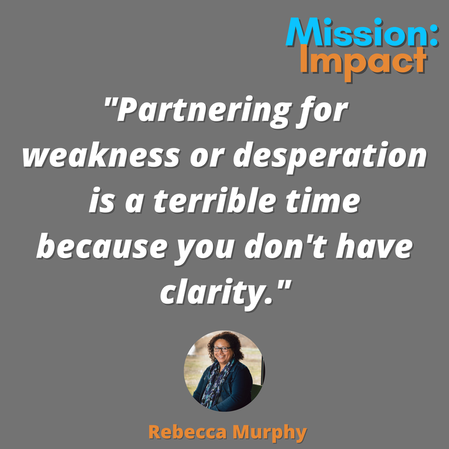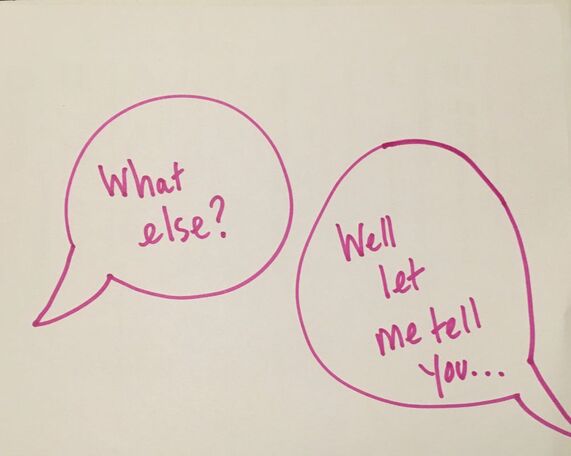Mission: Impact podcast & blog
Build a better world without becoming a martyr to your nonprofit cause
Listen on:
 This week we’re talking to Rebecca Murphy. We talked about:
Rebecca has been a consultant for over 20 years. She considers herself an “interpreter,” as she has worked in multiple sectors including government, nonprofit, business, and philanthropy. She is adept at explaining/translating one to another. She is a generalist with a broad knowledge base – including workforce development, affordable housing, parks and place making. She has expertise in capacity building, organizational and program development, strategic planning, with particular expertise in public-private partnerships, community engagement, and strategic collaborations. Hers is a mission-focused practice. She is passionate about mission fidelity, and avoiding mission creep. Links: https://rcmstrategicconsulting.com/ https://twitter.com/RCMStratConsult Click "Read More" for Transcript:  Through my strategic planning work I interview a lot of people. Most nonprofit consulting projects include some interviews or focus groups as part of the discovery process. I used to end my interviews with the question, “Is there anything else I need to know for this project/process?” Most of the time the answer would be, “no, nothing else.” Then one time I said, “What else do I need to know for this project/process?” And a whole lot more spilled out from the person I was talking with. “Is there anything else…?” “What else…?” doesn’t seem on surface to be very different. Yet it shifts the focus from a finite yes/no answer to the more open ended, “what else…?” And embedded in the question is the assumption that there is something else. Something else that I could not have anticipated in the questions I have already asked. Small tweaks can make a differenceIt seems like a little bit of a throw away. Yet often the most interesting and revealing answers are to that question.
So small tweaks can have a big impact. What small tweaks have you made recently in your work that had an impact? A Buddhist monk, a leftist guerrilla warrior and a technology executive walk into a bar called Changes. “Ah the nature of change,” the monk says, “the world is always in flux, permanence is an illusion and attachment to permanence is the cause of suffering.” The leftist guerrilla replies, “But Mao said there must be a great leap forward.” The tech executive says, “Fast Company says change is happening faster than ever and we must always be the next big thing.” The bartender shrugs her shoulders and asks how each of them is planning to pay for their beers. “Everyone with ATM money again?” she says, “Go somewhere else to make your change.” Can you manage change? Sorry for the poor attempt at humor. People talk about change management and say that that is what they do. But can you really manage change? I believe you can be intentional about moving toward change. Yet saying you are managing change gives an illusion of control that I do not think is real in dynamic human systems. Organizations are human systems and are describes as “intelligent, creative, adaptive, self-organizing, [and] meaning-seeking” as Meg Wheatley described. While you can force change on people, I do not believe you can force people to change. Yet saying you are managing change gives an illusion of control that I do not think is real in dynamic human systems. A sparkThere typically is a spark that initiates the change. This could come from outside the nonprofit organization – a crisis, a major shift in the market, a new mandate or regulation. Or it could come from inside the organization in the form of a vision championed by either formal leaders or through a bottom up effort of informal leaders. Focusing the effortWhen done well, the organization will take advantage of the spark by being intentional in focusing the change effort. Is the organization ready to change and makes the best of the challenge or opportunity? How will leaders choose to invest the time, energy and resources into envisioning and implementing change? What new structures need to be created to support the desired change going forward? Meaningful dialogueCreating organizational change intentionally means taking time to thoughtfully design and engage in meaningful dialogue. Does the past need to be mourned before a new beginning can be imagined? Is the environment safe enough for people to bring their whole selves to the endeavor? If not, what will increase those conditions of safety? Systems of supportOnce the change is implemented –whether it is new goals and aspirations envisioned in a strategic plan or implementing a new technology system or building a new program – ensuring you have systems in place to support the new change and allow it to take hold is key. Identifying, harnessing and sharing stories of success can be a powerful way to help the change stick.
What change are you trying to make in 2020? Let's talk about them  When I get caught up in an anxiety spiral, my thoughts quickly go worse case scenario. Something has happened, I get triggered and I run straight up the ladder of inference, jumping to all sorts of conclusions. Too often I am not even conscious that I have leapt from an incident – something someone did or did not do, something someone said, even a facial expression – to all sorts of beliefs about that, and most critically -- accepting those beliefs as fact. The ladder of inference created by Chris Argyris breaks down what our brains do so naturally and so quickly. We jump from the observable data to the data we pay attention. We then assign meaning to it, make assumptions, jump to conclusions based on our beliefs and then often take action based on this chain of thought. All this can happen in a split second. I have found that the ABC framework is a useful tool for slowing myself down and examining the validity of my thoughts and conclusions. Originating in cognitive psychology and the work of Aaron Beck, the acronym stands for Adversity, Belief and Consequences The tool is useful because it gives you a framework to break down what just happened. Here is an example of how you would use the tool: This first step captures what just happened. The next step is to examine those thoughts and beliefs. Then one step further takes each of the worse case scenario beliefs, examines their likelihood and helps you play out alternative scenarios as well as make sounder decisions about next steps. Adversity: A colleague yawns during my presentation. The next time you find yourself caught in an unhelpful thought loop try this out for yourself. Learn more in the book The Resilience Factor by Karen Reivich, PhD and Andrew Shatte, PhD.
Emerging from Crisis Photo by Pixabay Photo by Pixabay Challenge: A small watershed organization had survived a tumultuous several years after the death of its founder and long-standing executive director. During the founder’s tenure, the board had been a following, governance board. The board led by a new board chair had navigated many challenges including an unsuccessful merger attempt, theft by a caretaker at one of the organization’s properties and other problems. The board decided the organization needed to take stock and reimagine itself, making the most of the legacy left by the founder and rebuilding an organization to meet both today’s realities and live into a new vision its future. Approach: I interviewed the board members and supported board members as they interviewed external stakeholders. Through the interviews, it became clear that the organization while it wanted to engage in longer range strategic planning it was only in the position to do short range planning. Most board members had been involved with the organization for years and many were burned out. Yet some found it challenging to let go and allow new leadership to emerge. Many had come on during the founder’s tenure and were not prepared to engage in the hands on work that the organization now needed from its board and it now had no staff. I facilitated a one-day retreat to help the group uncover what they had learned from their experience and think about where the organization stood in terms of the phases of development that nonprofits typically go through and what it meant for what was required from the board at its present stage of development. Results: Over the course of the organization’s several years of turn around, the board chair had essentially been working part time for the organization without compensation. During the retreat, the board decided to make her executive director and pay her for her work. A new board chair was named. Several board members announced their departure making way for new leadership to engage with the organization. The board also set several short-term goals for the year. Building Shared Leadership Photo by rawpixel.com Photo by rawpixel.com Challenge: A well-respected state level education nonprofit decided to celebrate its 30-year anniversary by engaging in strategic planning to envision its future and set goals for the next 3-5 years. The organization had emerged from a challenging period in its history during which long-standing but no longer financially sustainable programs were sun-setted. The executive director who had been with the organization since its founding hoped to strengthen the organization’s staff and board leadership by increasing shared leadership. The board was small and the majority of it members are relatively new to the organization. The executive director priorities included considering whether the organization’s name adequately represents its work; how to build capacity within the staff and board for greater shared leadership with the executive director as well as longer-term succession planning. Approach: I interviewed all the board members, external stakeholders as well as the staff. I facilitated a session with board, staff and a few external stakeholders that encompassed a look back at the organization's accomplishments over its 30 year history, considered the trends in the wider environment impacting the organization and reviewed the themes that emerged from the interviews. The group then discussed what implications the trends and themes had for the organization as it considered its future direction. Results: Through the interviews a number of issues emerged including the weakness of the board. Through the feedback and discernment process in the first session, the board decided to take a break from strategic planning and focus on its own development. Six months later the board had recruited new members and taken steps to create more a sense of shared leadership with the executive director. Need similar results for your organization? Inquire about scheduling a coaching call. |
Archives
May 2024

Grace Social Sector Consulting, LLC, owns the copyright in and to all content in and transcripts of the Mission: Impact podcast, as well as the Mission: Impact blog with all rights reserved, including right of publicity.
|
Telephone301-857-9335
|
info[at]gracesocialsector.com
|
Grace Social Sector Consulting, LLC, owns the copyright in and to all content in, including transcripts and audio of the Mission: Impact podcast and all content on this website, with all rights reserved, including right of publicity.
|